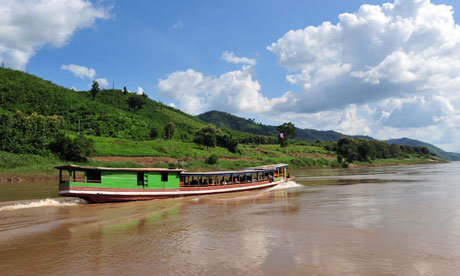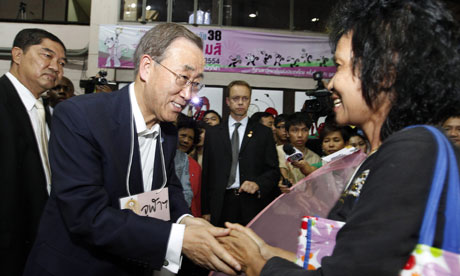A report commissioned by the Lao government gives the green light to a controversial dam.

Photo appears courtesy of International Rivers
A caterpillar works on the access road to the Xayaburi dam in Laos in an undated photo.
A
new report commissioned by the Lao government makes “false claims”
regarding the impact of a planned hydroelectric dam in the landlocked
country and should not be used as a basis for proceeding with the
project, according to a conservation group.
Despite
acknowledging uncertainties about how the Xayaburi Dam would affect
riparian communities in Laos and other countries along the Mekong River,
the report, released Wednesday by Swiss company Pöyry Energy AG,
recommends that the dam be built, falsely claiming concerns about the
project have been addressed, the U.S.-based International Rivers said in
a statement Wednesday.
“The Pöyry report sidesteps science and
relies instead on guesswork, making it an unsuitable basis for
decision-making on the Xayaburi Dam,” said Ame Trandem, Southeast Asia
Program Director for International Rivers.
“Pöyry claims that
the project complies with Mekong River Commission (MRC) guidelines,
despite listing over 40 major scientific and technical studies that
still need to be completed. It would be irresponsible of Laos and other
Mekong countries to support the Xayaburi Dam based on the false claims
of this report.”
The Lao government hired Pöyry Energy AG in
May to undertake a three-month evaluation of the project’s compliance
with the MRC’s requirements for Mekong Mainstream Dams after the
regional body decided in April to defer any decision on the U.S. $3.8
billion project to the end of 2011.
The MRC, which consists of
Laos and neighbors Thailand, Vietnam, and Cambodia, concluded at the
time that the potential for damage to rice farming and fishing
communities along the river warranted the suspension of work on the dam.
In early September, the Lao government announced that the Pöyry report
would be presented to neighboring governments as part of a plan to begin
full construction on the dam before the end of the year.
Sulasak Krahan, a public relations officer for the MRC, told RFA in an
interview that his organization had received a copy of the report and
was in the process of reviewing Pöyry’s findings.
“The MRC has
received the report on Xayaburi dam project and our experts are now
reviewing it. The review is expected to be completed soon and the MRC
will inform the public of our findings.”
While Laos has yet to publicly disclose the report, a leaked copy has recently been widely circulated.
Report shortcomings
International Rivers said it has identified at least 15 “fundamental”
MRC requirements with which the Xayaburi Dam still does not comply.
“The Pöyry report avoids mentioning many of these requirements, and
instead proposes unproven mitigation measures without having basic data
about who, what, when, and how much will be impacted,” International
Rivers said.
In particular, the group noted the report’s lack
of provisions for an MRC requirement that the dam include safe passage
for at least 95 percent of key fish species. Instead, it said, Pöyry
promoted technologies that have never been applied on the Mekong River
or used successfully in any tropical river.
“Fishery experts
from around the world have concluded that no technology exists to
effectively mitigate the impacts mainstream dams would have on the
world’s largest inland fishery,” International Rivers said.
The
river conservation group said it found several other shortcomings in
the Pöyry report, including analysis of ecosystems, sediment flows, and
dam safety.
Critics of the dam say it would destroy the river’s
ecology and disrupt the livelihood of riparian communities that rely on
it for their livelihood.
They also fear that proceeding with
the Xayaburi dam would give a green light to construction on as many as
10 other hydropower projects planned for the lower Mekong.
Several groups have issued warnings that any dam built in the area may
be at risk of collapse because the site is prone to earthquakes.
In the report, Pöyry falsely claims that a regional prior consultation
process on the Xayaburi is already complete and that the Lao government
can make a unilateral decision on whether to proceed on the dam,
International Rivers said.
“Pöyry incorrectly asserts that the
Lao government is not required to respond to the concerns of other
governments and the MRC about the project’s transboundary impacts before
the dam’s construction begins,” it said.
Map showing the proposed Xayaburi dam project.
Government push
International Rivers said that the Lao government had been working hard
to push the dam project forward—proceeding with construction on access
roads and work camps despite the lack of a regional agreement.
“It’s not surprising Laos has commissioned Pöyry as their hired gun
given their long history of involvement in controversial projects in the
Mekong region and their close ties to the Xayaburi Dam’s main builder,
Ch. Karnchang,” Trandem said in the statement.
“Poyry and Ch.
Karnchang are currently working together on another hydropower project
in Laos, the Nam Ngum 2 Dam. It comes as no surprise that Pöyry would
give its business partner a positive review, despite strong evidence to
the contrary.”
With plans to build a total of 70 hydropower projects, Laos hopes to become “the battery” of Asia.
International Rivers said that as the first Mekong mainstream dam to
undergo the MRC’s prior consultation process, the Xayaburi will set the
bar for how decisions are made on all 11 dams proposed for the river.
“Over 40 million people, or two-thirds of the population in the Lower
Mekong Basin, are involved in the Mekong’s fisheries at least part-time
or seasonally. The future lives of many depend on governments’
willingness to say no to the Xayaburi Dam,” it said.
A decision
on the Xayaburi Dam is expected to be made at the upcoming MRC Council
meeting, scheduled for Dec. 7-9 in Siem Reap, Cambodia.
Reported by RFA’s Lao service. Translated by Max Avary. Written in English with additional reporting by by Joshua Lipes.
Source:
http://www.rfa.org/english/news/laos/dam-11092011164208.html










 The
flood’s impact is more than just damages to homes and disrupting the
way of life. It entails waste contamination on a grand scale.
The
flood’s impact is more than just damages to homes and disrupting the
way of life. It entails waste contamination on a grand scale. Deluge
water is not only floodwater. Significant amounts of industrial waste,
hazardous substances, raw sewage and miscellaneous toxic chemicals have
been released into the environment as a result of the floods. The
government will put an expensive and large-scale restoration in place
when the flooding recedes, yet the clear and present danger of
environmental pollution has been largely overlooked. Even when an area
becomes dry, it may face long-term effects.
Deluge
water is not only floodwater. Significant amounts of industrial waste,
hazardous substances, raw sewage and miscellaneous toxic chemicals have
been released into the environment as a result of the floods. The
government will put an expensive and large-scale restoration in place
when the flooding recedes, yet the clear and present danger of
environmental pollution has been largely overlooked. Even when an area
becomes dry, it may face long-term effects. South
Korean President Lee Myung-Bak (right) ushers his Vietnamese
counterpart Truong Tan Sang during a welcoming ceremony at the Blue
House in Seoul. Vietnam has agreed to seek greater nuclear energy
cooperation with South Korea, opening the way for its participation in a
project to build atomic power plants in energy-hungry Vietnam.
South
Korean President Lee Myung-Bak (right) ushers his Vietnamese
counterpart Truong Tan Sang during a welcoming ceremony at the Blue
House in Seoul. Vietnam has agreed to seek greater nuclear energy
cooperation with South Korea, opening the way for its participation in a
project to build atomic power plants in energy-hungry Vietnam.  Villagers
looking down at their flooded houses from makeshift shelters set up on a
mountain in the Tan Hoa commune, in the central Vietnamese province of
Quang Binh, in October 2011. Almost all the victims of severe flooding
in Vietnam's Mekong Delta were children, the United Nations said on
Monday, as the official death toll climbed to 78.
Villagers
looking down at their flooded houses from makeshift shelters set up on a
mountain in the Tan Hoa commune, in the central Vietnamese province of
Quang Binh, in October 2011. Almost all the victims of severe flooding
in Vietnam's Mekong Delta were children, the United Nations said on
Monday, as the official death toll climbed to 78.